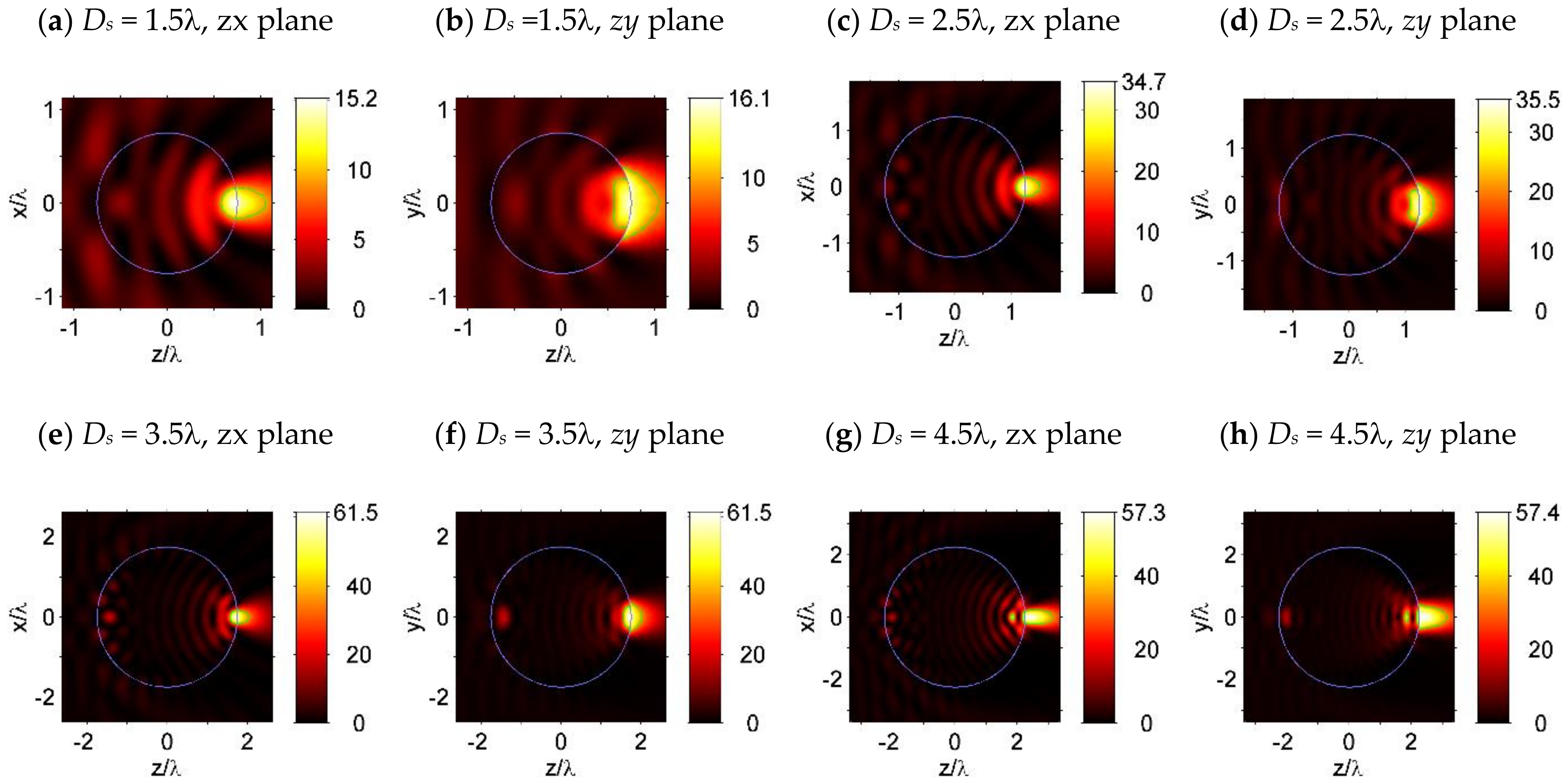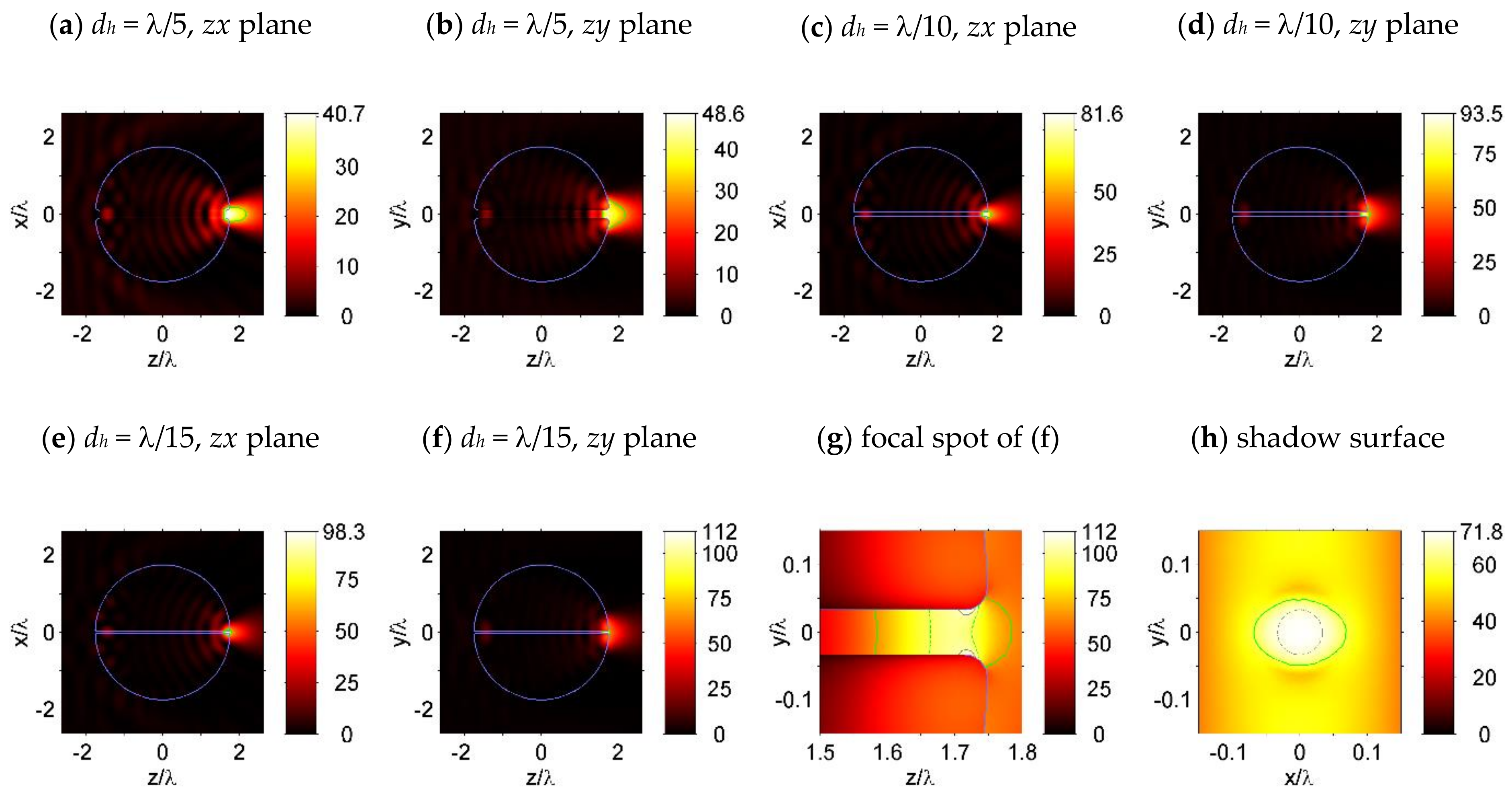Deep Subwavelength-Scale Light Focusing and Confinement in Nanohole-Structured Mesoscale Dielectric Spheres
Abstract
:1. Introduction
2. Dielectric Microspheres without Hole
3. Nanohole-Structured Dielectric Microspheres
3.1. Microspheres with a through Hole
3.2. Microspheres with a Blind Hole
4. Discussion
5. Conclusions
Author Contributions
Funding
Acknowledgments
Conflicts of Interest
References
- Heifetz, A.; Kong, S.C.; Sahakian, A.V.; Taflove, A.; Backman, V. Photonic Nanojets. J. Comput. Theor. Nanosci. 2009, 6, 1979–1992. [Google Scholar] [CrossRef] [PubMed]
- Minin, I.V.; Minin, O.V. Diffractive Optics and Nanophotonics: Resolution below the Diffraction Limit; Springer International Publishing: New York, NY, USA, 2016. [Google Scholar]
- Ferrand, P.; Wenger, J.; Devilez, A.; Pianta, M.; Stout, B.; Bonod, N.; Popov, E.; Rigneault, H. Direct imaging of photonic nanojets. Opt. Express 2008, 16, 6930–6940. [Google Scholar] [CrossRef] [PubMed]
- Lukyanchuk, B.S.; Dominguez, R.P.; Minin, I.V.; Minin, O.V.; Wang, Z. Refractive index less than two: Photonic nanojets yesterday, today and tomorrow. Opt. Mater. Express 2017, 7, 1820–1847. [Google Scholar] [CrossRef]
- Li, Y.; Xin, H.; Liu, X.; Zhang, Y.; Lei, H.; Li, B. Trapping and detection of nanoparticles and cells using a parallel photonic nanojet array. ACS Nano 2016, 10, 5800–5808. [Google Scholar] [CrossRef] [PubMed]
- Minin, I.V.; Minin, O.V.; Pacheco-Peña, V.; Beruete, M. Subwavelength, standing-wave optical trap based on photonic jets. Quantum Electron. 2016, 46, 555–557. [Google Scholar] [CrossRef]
- Yang, H.; Trouillon, R.; Huszka, G.; Gijs, M. Super-resolution imaging of a dielectric microsphere is governed by the waist of its photonic nanojet. Nano Lett. 2016, 16, 4862–4870. [Google Scholar] [CrossRef] [PubMed]
- Born, B.; Krupa, J.; Gagnon, S.; Holzman, J. Integration of photonic nanojets and semiconductor nanoparticles for enhanced all-optical switching. Nat. Commun. 2015, 6, 8097. [Google Scholar] [CrossRef] [PubMed]
- Liu, C.; Yen, T.; Minin, O.V.; Minin, I.V. Engineering photonic nanojet by a graded-index micro-cuboid. Physica E 2018, 98, 105–110. [Google Scholar] [CrossRef]
- Shen, Y.; Wang, L.; Shen, J. Ultralong photonic nanojet formed by a two-layer dielectric microsphere. Opt. Lett. 2014, 39, 4120–4123. [Google Scholar] [CrossRef] [PubMed]
- Yue, L.; Yan, B.; Monks, J.; Dhama, R.; Wang, Z.; Minin, O.V.; Minin, I.V. Intensity-enhanced apodization effect on an axially illuminated circular-column particle-lens. Ann. Phys. 2018, 530, 1700384. [Google Scholar] [CrossRef]
- Yue, L.; Yan, B.; Monks, J.; Wang, Z.; Tung, N.T.; Lam, V.D.; Minin, O.V.; Minin, I.V. Production of photonic nanojets by using pupil-masked 3D dielectric cuboid. J. Phys. D Appl. Phys. 2017, 50, 175102. [Google Scholar] [CrossRef]
- Gu, G.; Song, J.; Liang, H.; Zhao, M.; Chen, Y.; Qu, J. Overstepping the upper refractive index limit to form ultra-narrow photonic nanojets. Sci. Rep. 2017, 7, 5635. [Google Scholar] [CrossRef] [PubMed]
- Latimer, P. Light scattering by a structured particle: The homogeneous sphere with holes. Appl. Opt. 1984, 23, 1844. [Google Scholar] [CrossRef] [PubMed]
- Wu, M.X.; Huang, B.J.; Chen, R.; Yang, Y.; Wu, J.F.; Ji, R.; Chen, X.D.; Hong, M.H. Modulation of photonic nanojets generated by microspheres decorated with concentric rings. Opt. Express 2015, 23, 20096–20103. [Google Scholar] [CrossRef] [PubMed]
- Isro, S.D.; Iskandar, A.A.; Kivshar, Y.S.; Shadrilov, I.V. Engineering scattering patterns with asymmetric dielectric nanorods. Opt. Express 2018, 26, 32624. [Google Scholar] [CrossRef] [PubMed]
- Refractive Index Database. Available online: https://refractiveindex.info (accessed on 21 January 2019).
- Almeida, V.R.; Xu, Q.; Barrios, C.A.; Lipson, M. Guiding and confining light in void nanostructure. Opt. Lett. 2004, 29, 1209–1211. [Google Scholar] [CrossRef] [PubMed]
- Barrios, C.A.; Lipson, M. Electrically driven silicon resonant light emitting device based on slot-waveguide. Opt. Express 2005, 13, 10092. [Google Scholar] [CrossRef] [PubMed]
- Mason, D.R.; Jouravlev, M.V.; Kim, K.S. Enhanced resolution beyond the Abbe diffraction limit with wavelength-scale solid immersion lenses. Opt. Lett. 2010, 35, 2007–2009. [Google Scholar] [CrossRef] [PubMed]





| Ds | Sx | Sy | Sz | V | Imax |
|---|---|---|---|---|---|
| 1.5λ | 0.33λ | 0.77λ | 0.50λ | 0.057λ3 | 16.1I0 |
| 2.5λ | 0.32λ | 0.78λ | 0.43λ | 0.055λ3 | 35.5I0 |
| 3.5λ | 0.35λ | 0.74λ | 0.49λ | 0.051λ3 | 61.1I0 |
| 4.5λ | 0.50λ | 0.81λ | 0.81λ | 0.173λ3 | 57.4I0 |
| Ds | Sx | Sy | Sz | V | Imax |
|---|---|---|---|---|---|
| λ/5 | 0.39λ | 0.81λ | 0.63λ | 0.064λ3 | 48.6I0 |
| λ/10 | 0.25λ | 0.42λ | 0.27λ | 0.0033λ3 | 93.5I0 |
| λ/15 | 0.20λ | 0.14λ | 0.25λ | 0.0012λ3 | 112I0 |
© 2019 by the authors. Licensee MDPI, Basel, Switzerland. This article is an open access article distributed under the terms and conditions of the Creative Commons Attribution (CC BY) license (http://creativecommons.org/licenses/by/4.0/).
Share and Cite
Cao, Y.; Liu, Z.; Minin, O.V.; Minin, I.V. Deep Subwavelength-Scale Light Focusing and Confinement in Nanohole-Structured Mesoscale Dielectric Spheres. Nanomaterials 2019, 9, 186. https://doi.org/10.3390/nano9020186
Cao Y, Liu Z, Minin OV, Minin IV. Deep Subwavelength-Scale Light Focusing and Confinement in Nanohole-Structured Mesoscale Dielectric Spheres. Nanomaterials. 2019; 9(2):186. https://doi.org/10.3390/nano9020186
Chicago/Turabian StyleCao, Yinghui, Zhenyu Liu, Oleg V. Minin, and Igor V. Minin. 2019. "Deep Subwavelength-Scale Light Focusing and Confinement in Nanohole-Structured Mesoscale Dielectric Spheres" Nanomaterials 9, no. 2: 186. https://doi.org/10.3390/nano9020186
APA StyleCao, Y., Liu, Z., Minin, O. V., & Minin, I. V. (2019). Deep Subwavelength-Scale Light Focusing and Confinement in Nanohole-Structured Mesoscale Dielectric Spheres. Nanomaterials, 9(2), 186. https://doi.org/10.3390/nano9020186





